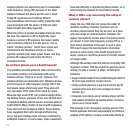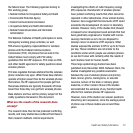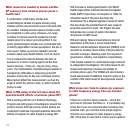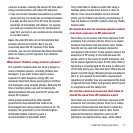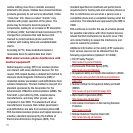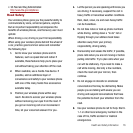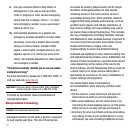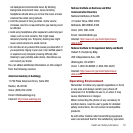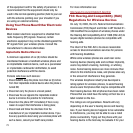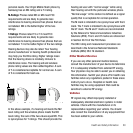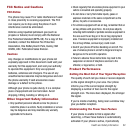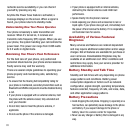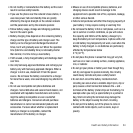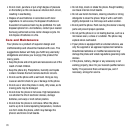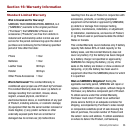
79
of the equipment and for the safety of personnel, it is
recommended that the equipment should only be
used in the normal operating position (held to your ear
with the antenna pointing over your shoulder if you
are using an external antenna).
Using Your Phone Near Other Electronic
Devices
Most modern electronic equipment is shielded from
radio frequency (RF) signals. However, certain
electronic equipment may not be shielded against the
RF signals from your wireless phone. Consult the
manufacturer to discuss alternatives.
Implantable Medical Devices
A minimum separation of six (6) inches should be
maintained between a handheld wireless phone and
an implantable medical device, such as a pacemaker
or implantable cardioverter defibrillator, to avoid
potential interference with the device.
Persons who have such devices:
•
Should ALWAYS keep the phone more than six (6) inches
from their implantable medical device when the phone is
turned ON;
•
Should not carry the phone in a breast pocket;
•
Should use the ear opposite the implantable medical
device to minimize the potential for interference;
•
Should turn the phone OFF immediately if there is any
reason to suspect that interference is taking place;
•
Should read and follow the directions from the
manufacturer of your implantable medical device. If you
have any questions about using your wireless phone with
such a device, consult your health care provider.
For more information see:
http://www.fcc.gov/oet/rfsafety/rf-faqs.html
FCC Hearing-Aid Compatibility (HAC)
Regulations for Wireless Devices
On July 10, 2003, the U.S. Federal Communications
Commission (FCC) Report and Order in WT Docket 01-
309 modified the exception of wireless phones under
the Hearing Aid Compatibility Act of 1988 (HAC Act) to
require digital wireless phones be compatible with
hearing-aids.
The intent of the HAC Act is to ensure reasonable
access to telecommunications services for persons
with hearing disabilities.
While some wireless phones are used near some
hearing devices (hearing aids and cochlear implants),
users may detect a buzzing, humming, or whining
noise. Some hearing devices are more immune than
others to this interference noise, and phones also vary
in the amount of interference they generate.
The wireless telephone industry has developed a
rating system for wireless phones, to assist hearing
device users find phones that may be compatible with
their hearing devices. Not all phones have been rated.
Phones that are rated have the rating on their box or a
label located on the box.
The ratings are not guarantees. Results will vary
depending on the user's hearing device and hearing
loss. If your hearing device happens to be vulnerable
to interference, you may not be able to use a rated
phone successfully. Trying out the phone with your
hearing device is the best way to evaluate it for your



